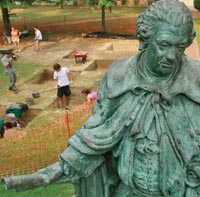Digging Up the Old Garden (the Really Old Garden)
Digging up the past isn’t a favored pastime for most. But this
summer a number of William and Mary undergraduates did just that, and
they relished it.
The campus just doesn’t look like it used to.
“I did not know that just digging can be interesting,” said Hiroaki Umehara.
Hiroaki was one of a half-dozen William and Mary undergraduates who spent the summer digging for evidence of former gardens in the College’s Wren Yard with anthropology instructor Steve Archer. Under Archer’s tutelage the students uncovered what appears to be evidence of an 18th-Century ditch, hedge rows and pathways.
“It’s a really well preserved cluster of features that align really well—the ditch and the planting holes, matching with the next line of at least one tree hole,” Archer said.
The Wren Yard surrounds the oldest building on the William and Mary campus, the Sir Christopher Wren Building. The building once housed the entire College and is still in use today as an academic building.
This summer’s excavation was the third conducted by student archaeologists under Archer’s guidance. Though the first dig turned up little, Archer wasn’t deterred. Last year’s dig was more fruitful—the team found evidence of topiary planting holes and some pathways. But this year’s finds have been the most impressive by far.
Recorded descriptions of the grounds appearance are few. One possible view came to light in the late 1920s when researchers discovered a printing plate in England’s Bodleian Library depicting the Wren Building and its grounds. Still, little was known about
|
Related Content: W&M News: Ideation magazine: |
the presence of the formal gardens depicted in the plate until Archer’s teams began digging for evidence two years ago. This year the team also found evidence of two closely configured planting holes—one cutting into the other, Archer said.
“You can actually see where one of the hedge plantings died and they had to dig it out and put in a new one,” Archer said. “It is, sort of a repair there to the hedging. You can actually sort of see them maintaining the garden a little bit, which is a neat find.” Archer, who
is also a research archaeologist at the Colonial Williamsburg Foundation, noted they found other signs of the garden.
“We have sort of a consistent division where there is marl on the north half of these units (the digging squares) as we come down to the features but it’s not on the south half,” he explained. Archer noted that this marl would be consistent with an area depicted on the Bodleian Plate between the hedgerows flanking the center pathway.
With the answers to the mystery of the Bodleian Plate seemingly in hand, the team is turning its attention to what might have been the next design.
“What’s a little intriguing is that we keep getting hints that go in and out about what was happening out here in the late 18th Century,” Archer said.
The team also found evidence this summer of two diagonal walkways—one believed to be a 19th-Century path following a line that would have connected the Wren Building to the Brafferton and another 18th-Century path. Archer explained that the amount of fill found with the 18th-Century feature suggests that it was the active path between the Wren Building and the Brafferton in the latter part of that century.
“That means the formal garden would have been gone by then,” he said. “So we are trying to get the tail end of that Bodleian Plate design. It’s all little bits and pieces; you have to find out how everything fits together.”
The student archaeologists, some participating in a dig for the first time, enjoyed the opportunity.
“Archaeology has nothing to do with anything else I’m doing academically, but I enjoyed the change of pace,” said senior Caroline Lindsey. “It was also valuable to take advantage of W&M’s location and have an experience that is only possible in Colonial Williamsburg. I’ve done lots of undergraduate research through the Monroe Scholar program, but it’s always involved lots of time in the library. It was great trying something more hands-on.”
While Caroline was happy to be out of the library, others clamored to get in and do more research. The answers found by the archaeological evidence, as well as the new questions they raise, are the topic this semester of a special class taught at the College by Archer.
The class, Garden Archaeology, is taking a closer look at the artifacts discovered in this summer’s dig and, in some cases, looking for historical clues to support or refute theories on the summer’s findings.
“The class is a really good idea,” said senior Graham Callaway, one of Archer’s summer researchers. “It allows for questions to be asked of the data that an individual researcher would never have had time to ask.”
Each member of the three-credit class is designing their own research project. The topics range from examining the influence the introduction of the Brafferton had on the Wren Yard to researching the use of digital mapping to “unearth” archaeological features on the grounds.
The Wren Yard digs and class are supported by Board of Visitors Secretary Suzann Matthews, a member of the class of 1971.
While the research continues, Archer notes that a lot of progress has been made. He plans to present all the findings of the Wren Yard excavations and the classroom research in an exhibition and report in spring semester. Currently, there are no plans for further excavations in the Wren Yard—“leaving that,” he says, “for future generations.”
 Skip to main content
Skip to main content
